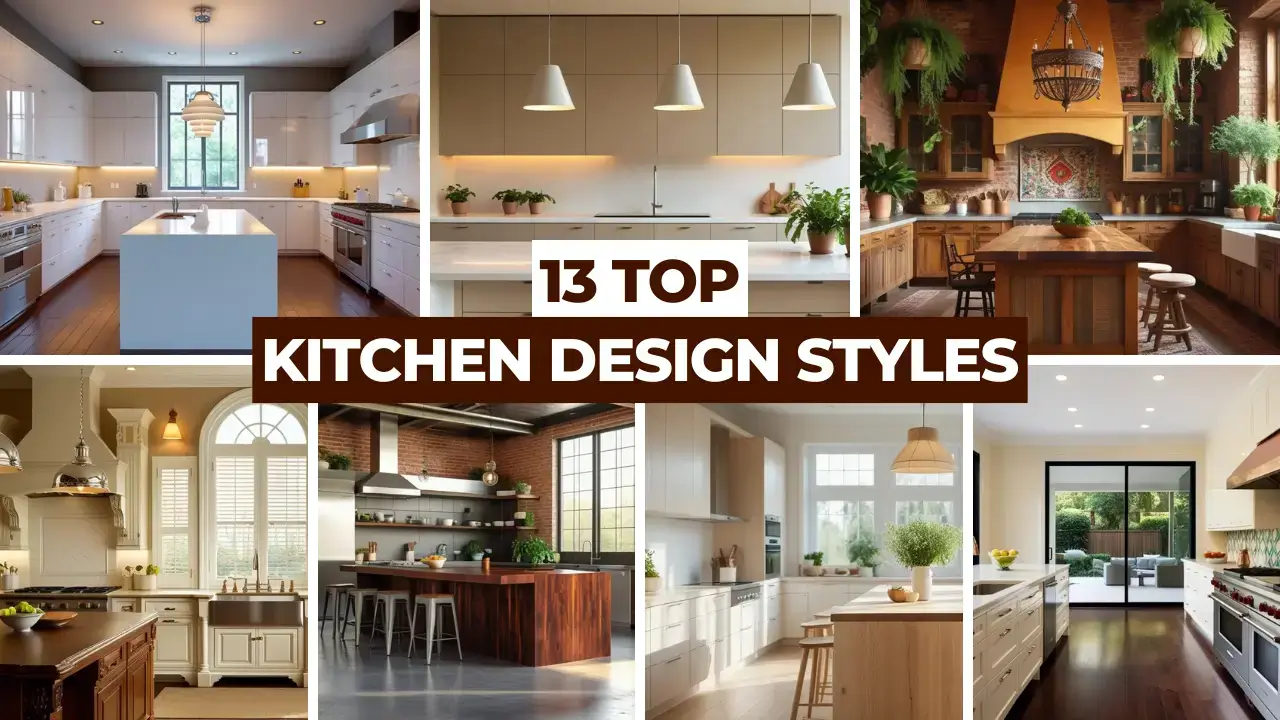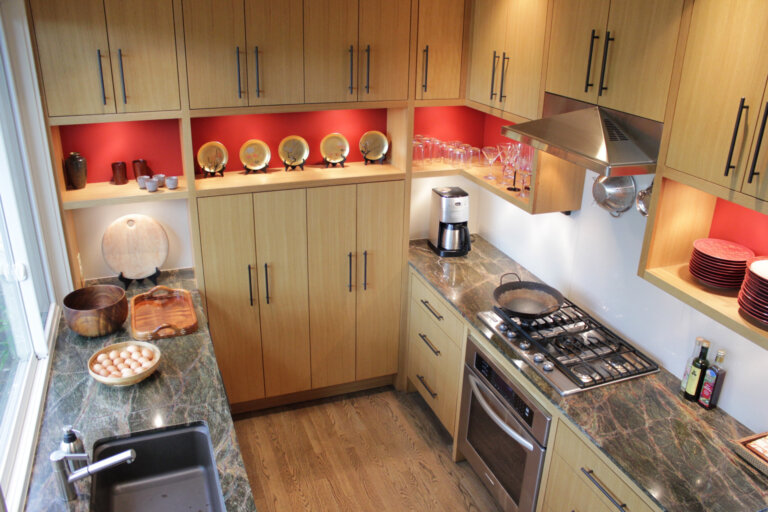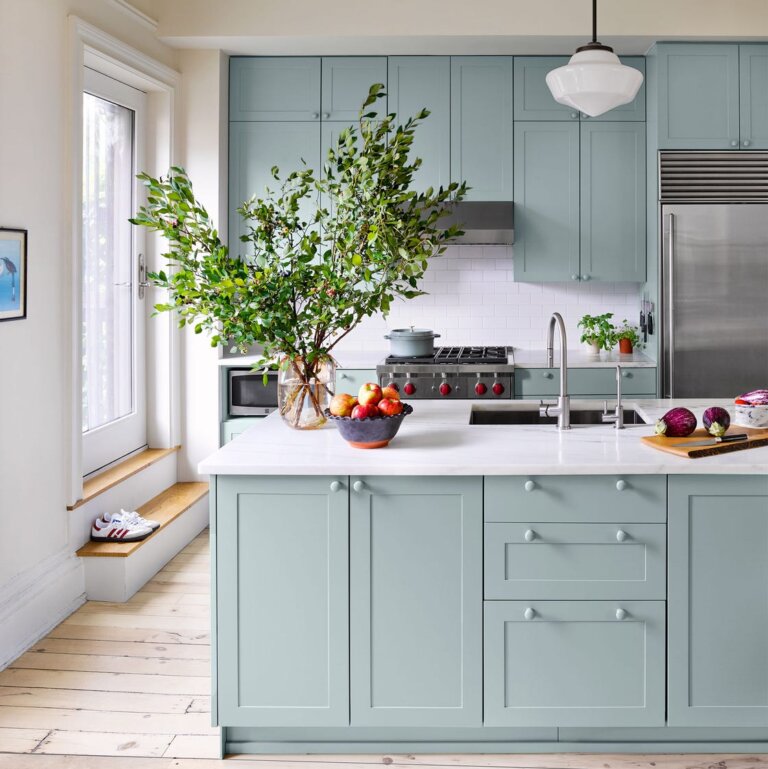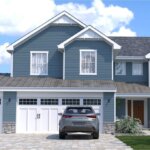Introduction
Looking to transform your kitchen but not sure where to start? Choosing the right kitchen design style can make all the difference in how your space feels and functions. Whether you’re dreaming of a sleek modern kitchen, a cozy farmhouse vibe, or something uniquely you, exploring the 13 top kitchen design styles is the perfect place to begin.
Each kitchen style brings its own charm, layout, and personality to the table—literally. From clean-lined minimalism to rich, traditional elegance, the possibilities are endless. The best part? You don’t have to be an interior designer to create a beautiful, functional kitchen that reflects your lifestyle. All it takes is a little inspiration and the right guidance.
In this ultimate guide, we’ll walk you through the top 13 kitchen design styles that are making waves in 2025—from rustic to Scandinavian, industrial to Mediterranean. Whether you’re remodeling, building from scratch, or just daydreaming about your future kitchen, this list will help you find the perfect fit.
Get ready to discover the most popular, stylish, and practical kitchen ideas that will not only elevate your cooking space but also add serious value to your home.
Let’s dive into the 13 top kitchen design styles that are shaping homes everywhere.
13 Top Kitchen Design Styles Cost Calculator
1. Modern Kitchen Design
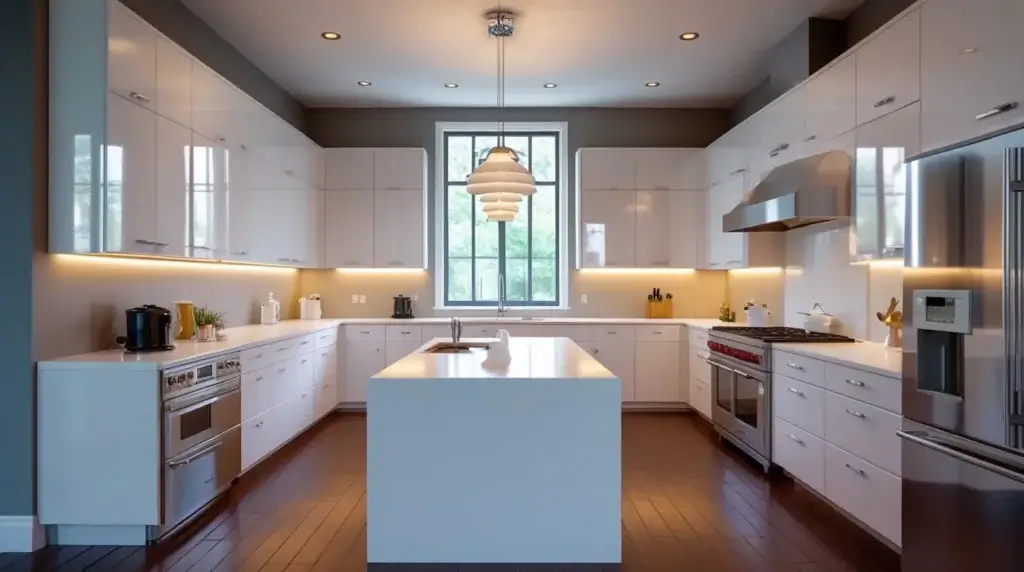
Key Features of Modern Kitchens
Modern kitchens are all about clean lines, minimalism, and functionality. Imagine a space where everything has its place, and there’s a seamless flow from one element to the next. You’ll often find flat-panel cabinetry, sleek hardware (or even no hardware), and built-in appliances that blend right into the cabinetry. There’s no room for ornate details here—it’s all about simplicity and order.
This style prioritizes uncluttered counters and efficient layouts. Think of it as the kitchen equivalent of a perfectly organized closet. The layout often incorporates smart storage solutions like pull-out pantry shelves, deep drawers, and hidden compartments to keep everything neat.
Best Materials and Finishes
Materials used in modern kitchen design typically include high-gloss laminates, stainless steel, quartz countertops, and glass backsplashes. Concrete and matte black finishes have also become trendy choices, especially when paired with white or gray tones.
As for color, modern kitchens usually stick to a neutral palette—white, gray, black, and sometimes navy blue. Pops of color may be introduced subtly through a kitchen island or backsplash, but the main look stays streamlined.
Who It’s For
If you’re a fan of clean, minimal spaces or you’re someone who hates clutter, modern kitchen design could be your perfect match. It’s ideal for city apartments and contemporary homes, and it complements a high-tech lifestyle with its smart appliances and sleek aesthetics.
Pros:
- Sleek and Minimalist Aesthetic: Clean lines and simple forms create a calm, clutter-free environment.
- Functional and Efficient Layout: Smart storage solutions maximize space and organization.
- Durable, Easy-to-Clean Materials: Stainless steel, quartz, and laminates offer longevity and low maintenance.
- Integration with Technology: Built-in smart appliances enhance convenience and modern living.
- Neutral Palette: Flexible color scheme that easily adapts to personal style with subtle accents.
Cons:
- Can Feel Cold or Sterile: Minimalism and neutral colors may lack warmth or coziness.
- Limited Ornamental Character: May not suit those who prefer traditional or eclectic styles.
- Potentially Higher Initial Cost: High-quality materials and built-in tech can increase upfront expenses.
- Less Customizable Visual Variety: Emphasis on simplicity might restrict bold personal touches.
- Maintenance of Glossy Surfaces: High-gloss finishes can show fingerprints and scratches easily.
Estimated Cost Table for Modern Kitchen Design
| Item / Feature | Estimated Cost Range (USD) | Notes |
|---|---|---|
| Flat-panel Cabinetry | $8,000 – $15,000 | Depends on materials (laminate vs wood) |
| Built-in Appliances | $5,000 – $15,000 | Smart appliances add to the price |
| Quartz Countertops | $3,000 – $6,000 | Durable and stylish but pricier |
| Glass Backsplash | $1,200 – $2,500 | Adds sleek look, cost varies by design |
| High-gloss Laminate Finish | $2,000 – $4,000 | Affordable with modern aesthetic |
| Smart Storage Solutions | $1,000 – $3,000 | Pull-out shelves, deep drawers, etc. |
| Installation & Labor | $3,000 – $7,000 | Depending on complexity and location |
Transform Your Kitchen with AI – Click Here to Start
2. Traditional Kitchen Design

Classic Elements
Traditional kitchens are timeless for a reason. They’re warm, inviting, and often filled with beautiful craftsmanship. Crown molding, raised-panel cabinets, and antique finishes are hallmarks of this style. You’ll often see elements like ornate corbels, decorative lighting, and glass-front cabinet doors that add a touch of elegance.
Furniture-style cabinetry and inset doors give traditional kitchens a refined look, while decorative range hoods and apron-front sinks add charm. It’s the kind of kitchen that makes you want to slow down and enjoy a cup of tea at the counter.
Colors and Materials Used
Wood is the star in traditional kitchens—think cherry, mahogany, walnut, or painted finishes like cream and soft gray. Countertops are typically granite or marble, and backsplashes often use ceramic or stone tiles. Brass or oil-rubbed bronze hardware ties everything together with a warm glow.
Soft, muted colors dominate the palette—beiges, creams, and light blues are common, often paired with classic patterned tile work for added detail.
Why It’s Still Popular
This style never goes out of fashion because it speaks to comfort and heritage. It’s ideal for families, entertainers, and anyone who enjoys a kitchen that feels like the heart of the home. Traditional design also adds great resale value, as it tends to appeal to a wide range of buyers.
Pros:
- Timeless and Inviting: Classic elements create a warm, cozy atmosphere that feels like home.
- Rich Craftsmanship: Detailed woodworking and decorative accents add character and elegance.
- Durable Natural Materials: Wood cabinetry and stone countertops are sturdy and long-lasting.
- High Resale Value: Appeals to a broad audience, enhancing home marketability.
- Comfort-Oriented: Designed for socializing and family gatherings, making it functional and welcoming.
Cons:
- Can Feel Heavy or Overly Ornate: Excessive decoration might overwhelm smaller spaces.
- Higher Maintenance: Natural wood and stone surfaces require regular upkeep and care.
- More Expensive Materials: Quality hardwoods and stone can be costly.
- Less Modern Functionality: May lack integration with latest smart appliances or minimalistic layouts.
- Color Palette May Feel Dated: Muted tones and traditional patterns might not appeal to contemporary tastes.
Estimated Cost Table for Traditional Kitchen Design
| Item / Feature | Estimated Cost Range (USD) | Notes |
|---|---|---|
| Raised-panel Wood Cabinetry | $10,000 – $20,000 | Depends on wood type and finish |
| Granite or Marble Countertops | $4,000 – $8,000 | Durable but higher-end materials |
| Ceramic or Stone Backsplash | $1,500 – $3,000 | Classic patterned tiles increase cost |
| Brass or Oil-Rubbed Hardware | $800 – $2,000 | Adds warmth and character |
| Decorative Range Hood | $2,000 – $5,000 | Custom or ornate styles cost more |
| Apron-front Sink | $800 – $1,500 | Adds charm and traditional appeal |
| Installation & Labor | $4,000 – $8,000 | Skilled craftsmanship may increase labor costs |
Let AI Redesign Your Dream Kitchen – Click Here
3. Contemporary Kitchen Design
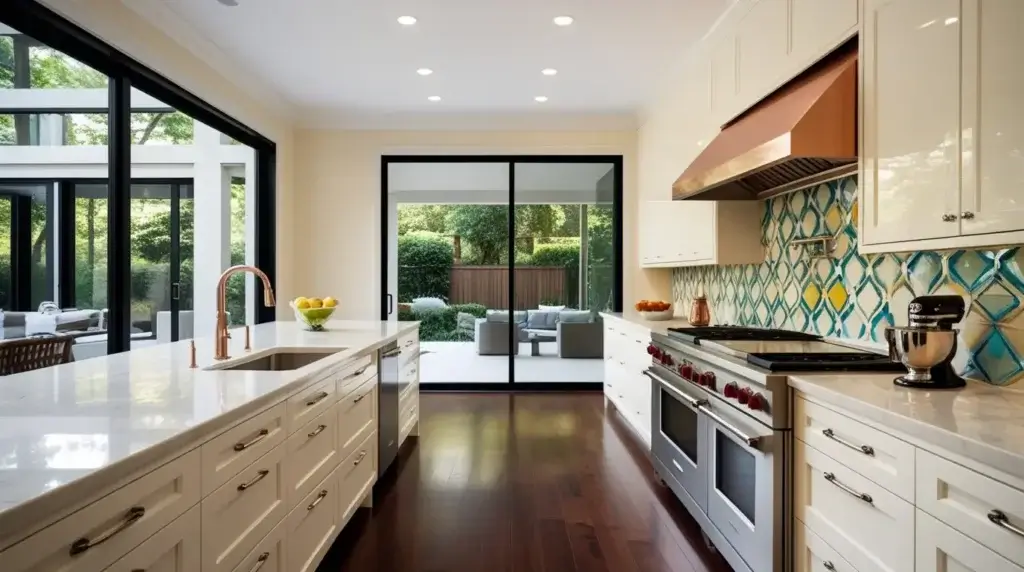
Flexibility and Flow
Many people confuse contemporary with modern, but there’s a key difference: contemporary design evolves with the times. While modern design sticks to the mid-century roots, contemporary kitchens reflect what’s trending now—which means more flexibility in materials, shapes, and even layouts.
Contemporary kitchens often feature open floor plans, eco-friendly materials, and smart technology. They’re known for their balance of style and function, combining modern aesthetics with personalized touches.
Modern vs. Contemporary
While modern kitchens lean towards minimalism and stark contrasts, contemporary kitchens are a little more fluid. They might include natural wood tones, organic shapes, or even bold colors, as long as everything feels intentional and cohesive.
Where modern kitchens say “don’t touch,” contemporary kitchens say “come in and cook.”
Tips for Styling a Contemporary Kitchen
To get the contemporary look, start with a neutral base and add in trending elements like open shelving, a statement backsplash, or matte finishes. Mix materials like wood and metal to add dimension. Don’t be afraid of bold lighting or custom islands—they’re the perfect opportunity to infuse personality.
Pros:
- Highly Flexible and Adaptive: Reflects current trends and personal style, allowing for evolving design choices.
- Open and Airy Layouts: Promotes a spacious feel with seamless flow, perfect for socializing and multitasking.
- Eco-Friendly Options: Incorporates sustainable materials appealing to environmentally conscious homeowners.
- Balanced Style and Function: Combines modern aesthetics with practical elements and smart technology.
- Personalization Friendly: Allows mixing materials, bold colors, and unique design elements for a custom look.
Cons:
- Can Become Outdated Quickly: Trend-driven elements might feel old-fashioned as styles evolve.
- Potentially Complex Designs: Mixing materials and textures requires thoughtful execution to avoid visual clutter.
- Moderate to High Costs: Custom islands, statement backsplashes, and smart tech can add up.
- Less Uniformity: Lack of strict style rules may confuse some homeowners or make resale staging harder.
- Maintenance Varies: Some trendy materials or finishes may need special care.
Estimated Cost Table for Contemporary Kitchen Design
| Item / Feature | Estimated Cost Range (USD) | Notes |
|---|---|---|
| Eco-friendly Cabinetry | $8,000 – $16,000 | Materials like bamboo or reclaimed wood |
| Custom Statement Backsplash | $1,500 – $3,500 | Artistic tiles or bold patterns |
| Matte Finish Countertops | $3,500 – $7,000 | Popular materials include quartz and concrete |
| Open Shelving & Lighting | $1,000 – $3,000 | Modern shelving and statement light fixtures |
| Smart Appliances | $5,000 – $12,000 | High-tech, energy-efficient appliances |
| Custom Kitchen Island | $4,000 – $10,000 | Can be a focal point, varies by size and materials |
| Installation & Labor | $3,500 – $7,500 | Complex installs can increase labor cost |
Smarter Kitchen Design Starts with AI – Click Now
4. Rustic Kitchen Design

Natural Materials and Textures
Rustic kitchens bring the beauty of nature indoors. Reclaimed wood, stone walls, exposed beams, and distressed finishes define this look. The materials should feel raw, organic, and real—like they’ve stood the test of time. It’s a style that evokes cabins, mountain lodges, and countryside living.
Furniture and decor in rustic kitchens often feel handmade. Wooden tables, open shelves, and wrought-iron accents complete the picture. The overall atmosphere should feel warm and grounded.
Creating a Cozy Vibe
To build that warm and welcoming feel, lighting is key. Think Edison bulbs, lantern-style pendants, or chandeliers made from antlers or wood. Natural light should be maximized wherever possible. Also, throw in vintage accessories—like ceramic jugs or antique cookware—for a lived-in touch.
Flooring in rustic kitchens is usually wide plank wood or textured stone, which not only looks beautiful but is built to last.
Styling Tips
Layer in texture everywhere—from rough wood to soft textiles. Use earthy tones like browns, greens, and muted reds. A farmhouse sink or a vintage stove can be a statement piece, while open shelving with clay pots or copper pans adds charm.
Pros:
- Warm and Inviting Atmosphere: Natural materials and textures create a cozy, lived-in feel.
- Unique Character: Use of reclaimed wood, stone, and vintage décor adds personality and charm.
- Durability: Materials like wide plank wood and stone flooring are built to last.
- Timeless Appeal: Rustic style connects with nature and tradition, offering long-term satisfaction.
- Customization Friendly: Handmade furniture and handcrafted details allow for personalization.
Cons:
- Potentially High Maintenance: Natural materials may require more upkeep (e.g., wood refinishing, sealing stone).
- Can Feel Heavy or Dark: Without proper lighting, the space might look cramped or gloomy.
- Less Suitable for Small Spaces: Rustic elements can overwhelm compact kitchens.
- Costly Materials: Reclaimed wood, quality stone, and artisan lighting fixtures can be expensive.
- Limited Modern Integration: May lack seamless tech integration compared to modern or contemporary styles.
Estimated Cost Table for Rustic Kitchen Design
| Item / Feature | Estimated Cost Range (USD) | Notes |
|---|---|---|
| Reclaimed Wood Cabinetry | $9,000 – $18,000 | Custom finishes and distressed look |
| Stone or Wide Plank Flooring | $5,000 – $10,000 | Durable and authentic, varies by material |
| Farmhouse Sink & Vintage Stove | $1,500 – $4,000 | Signature rustic features |
| Wrought-Iron Lighting | $1,000 – $3,500 | Edison bulbs, lanterns, chandeliers |
| Open Shelving with Rustic Decor | $800 – $2,000 | Adds charm with clay pots, copper pans |
| Natural Stone Backsplash | $1,500 – $3,500 | Enhances natural look |
| Installation & Labor | $4,000 – $9,000 | Skilled craftsmanship needed |
Reimagine Your Kitchen Using AI – Explore Now
5. Farmhouse Kitchen Design
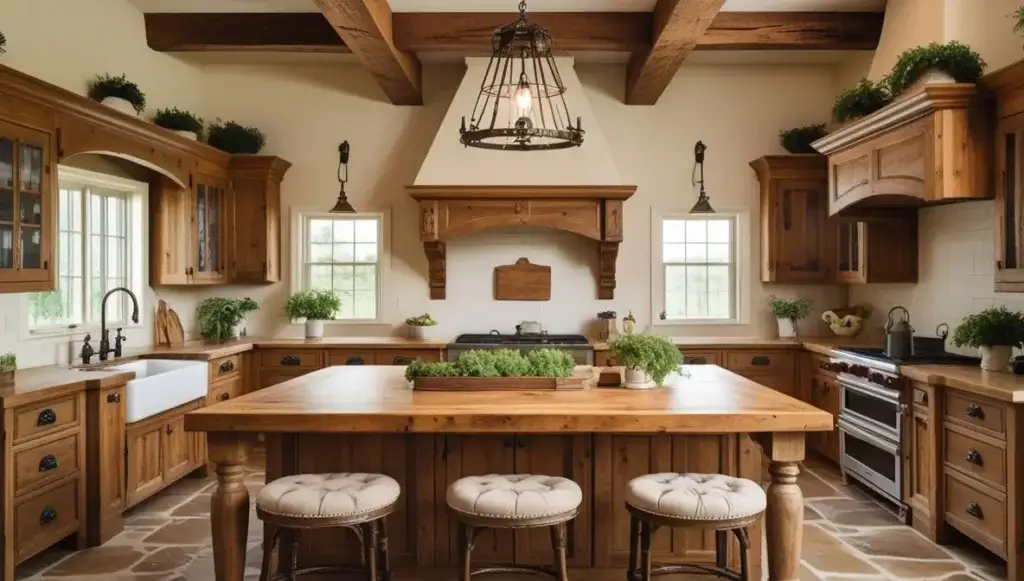
Hallmarks of a Farmhouse Kitchen
Farmhouse kitchens are one of the most beloved styles—and for good reason. They’re nostalgic yet functional, offering a cozy, lived-in feel with practical details. Key elements include apron-front sinks, shiplap walls, large islands, and wide open layouts perfect for gathering.
These kitchens invite you to cook from scratch, serve up homemade meals, and stay a while. They often feature large dining areas, making them perfect for family and social gatherings.
How to Get the Look
Start with shaker-style cabinets, a large farmhouse sink, and a classic subway tile backsplash. Open shelves displaying mason jars, dishware, or antique kitchen tools add character. For countertops, butcher block is a go-to choice, though quartz with a matte finish is becoming more common.
Mix vintage elements with newer pieces—a reclaimed wood table paired with metal chairs, or a retro-style fridge in a modern color.
Why It Feels Like Home
The farmhouse style connects us to tradition and simplicity. It’s functional, beautiful, and inviting all at once. For homeowners who value comfort, charm, and a little bit of nostalgia, the farmhouse kitchen is hard to beat.
Pros:
- Warm and Inviting: Nostalgic, cozy vibe that encourages family gatherings and socializing.
- Highly Functional Layout: Large islands and open spaces optimize cooking and entertaining.
- Timeless Appeal: Classic elements like shaker cabinets and apron sinks remain popular over time.
- Mix of Old and New: Flexibility to combine vintage charm with modern conveniences.
- Customizable Decor: Open shelving and display areas add personality and practical storage.
Cons:
- Can Feel Busy or Cluttered: Open shelves and lots of decorative items may create visual clutter.
- Maintenance on Wood and Butcher Block: Requires regular care to keep surfaces in good condition.
- Potentially Larger Footprint Needed: Best suited to spacious kitchens due to wide layouts and large islands.
- Less Sleek and Minimal: May not appeal to fans of ultra-modern or minimalist designs.
- Moderate to High Cost: Quality farmhouse sinks, wood countertops, and custom cabinetry can add up.
Estimated Cost Table for Farmhouse Kitchen Design
| Item / Feature | Estimated Cost Range (USD) | Notes |
|---|---|---|
| Shaker-style Cabinets | $9,000 – $17,000 | Classic design, solid wood or MDF options |
| Apron-front (Farmhouse) Sink | $1,200 – $3,000 | Signature piece, often ceramic or stainless steel |
| Butcher Block or Quartz Countertops | $3,000 – $6,000 | Butcher block needs upkeep; quartz is low maintenance |
| Subway Tile Backsplash | $1,200 – $2,500 | Simple, timeless tile |
| Open Shelving & Vintage Decor | $800 – $2,000 | Adds charm, storage, and display space |
| Large Kitchen Island | $4,000 – $9,000 | Multi-functional, size varies |
| Installation & Labor | $3,500 – $7,500 | Skilled carpentry and finish work |
AI-Powered Kitchen Makeover – Click Here to Begin
6. Industrial Kitchen Design
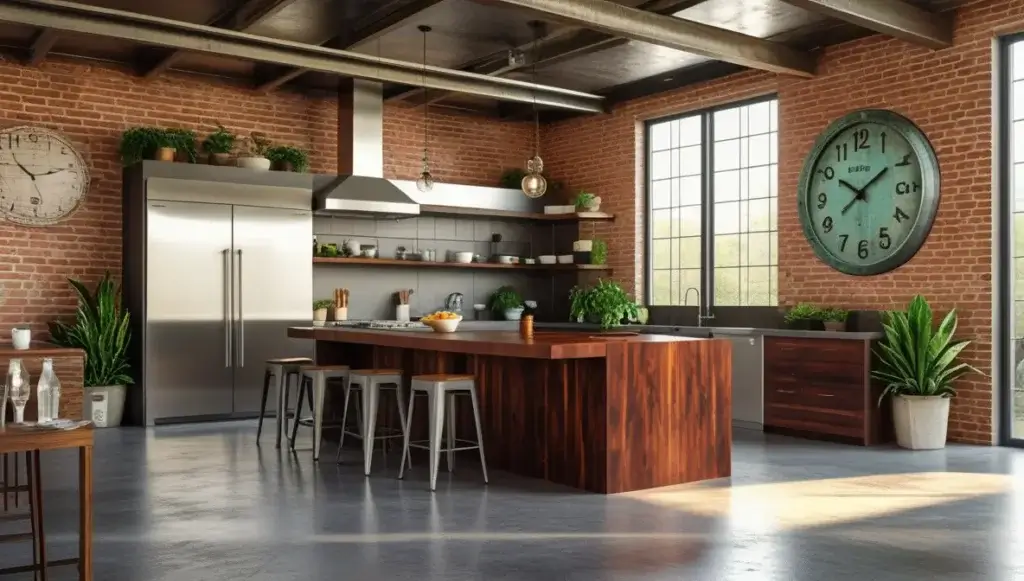
Urban and Raw Aesthetics
Industrial kitchen design draws inspiration from old factories and urban lofts, giving off a raw and edgy vibe. It’s like walking into a New York loft: exposed brick walls, visible ductwork, and metal surfaces come together to create a space that feels both rugged and chic.
Steel, iron, and unfinished wood are the dominant materials, often left intentionally raw or distressed. Concrete floors, subway tile backsplashes, and industrial-style lighting fixtures (like metal pendants and cage lights) complete the look. There’s nothing delicate here—it’s all about bold, durable elements.
Must-Have Elements
To nail the industrial kitchen aesthetic, you’ll want to focus on three main areas: materials, lighting, and layout. Stainless steel appliances are a must—they echo the metallic look and are built for heavy use. Open shelving, metal stools, and wire storage add to the utilitarian vibe.
The color palette typically includes blacks, grays, and metallic tones, with occasional pops of warm brown from leather bar stools or reclaimed wood counters. The goal is to feel raw and unrefined—but in a totally intentional way.
Balancing Industrial with Warmth
Too much industrial and your kitchen might start to feel cold. That’s where balancing comes in. You can soften the space with warmer elements—wooden accents, vintage rugs, soft lighting, or even plants. Mixing in a few cozy textures helps keep the space livable and welcoming.
Industrial kitchens are perfect for city dwellers, fans of minimalist design, and anyone who loves a bit of grit with their glam.
Pros:
- Bold and Stylish: Unique urban loft vibe that stands out with raw, edgy aesthetics.
- Durable Materials: Steel, iron, and concrete surfaces are built to last and easy to maintain.
- Functional Layouts: Open shelving and utilitarian design promote efficiency.
- Easy to Personalize: Mix of metal, wood, and warm accents creates a balanced atmosphere.
- Great for Urban Spaces: Fits perfectly in city apartments or loft-style homes.
Cons:
- Can Feel Cold or Harsh: Raw materials and metallic finishes may lack warmth if not balanced well.
- Not Ideal for Traditionalists: Industrial’s edgy look may not suit everyone’s taste or home style.
- Potentially High Installation Costs: Exposed ductwork, brick walls, and custom lighting can be expensive.
- Limited Color Palette: Mostly grays, blacks, and metallics might feel monotonous.
- Maintenance of Some Materials: Concrete floors and metal surfaces may show wear or require sealing.
Estimated Cost Table for Industrial Kitchen Design
| Item / Feature | Estimated Cost Range (USD) | Notes |
|---|---|---|
| Exposed Brick or Concrete Walls | $3,000 – $7,000 | Can be structural or faux finishes |
| Stainless Steel Cabinetry | $10,000 – $18,000 | Durable, industrial look |
| Concrete or Polished Floors | $5,000 – $12,000 | Requires sealing and maintenance |
| Metal Pendant & Cage Lighting | $1,200 – $3,000 | Signature industrial fixtures |
| Open Metal Shelving & Storage | $1,000 – $2,500 | Functional and decorative |
| Stainless Steel Appliances | $6,000 – $15,000 | Heavy-duty, complements style |
| Installation & Labor | $4,000 – $9,000 | Skilled labor needed for unique materials and design |
Design the Perfect Kitchen with AI – Get Started
7. Scandinavian Kitchen Design
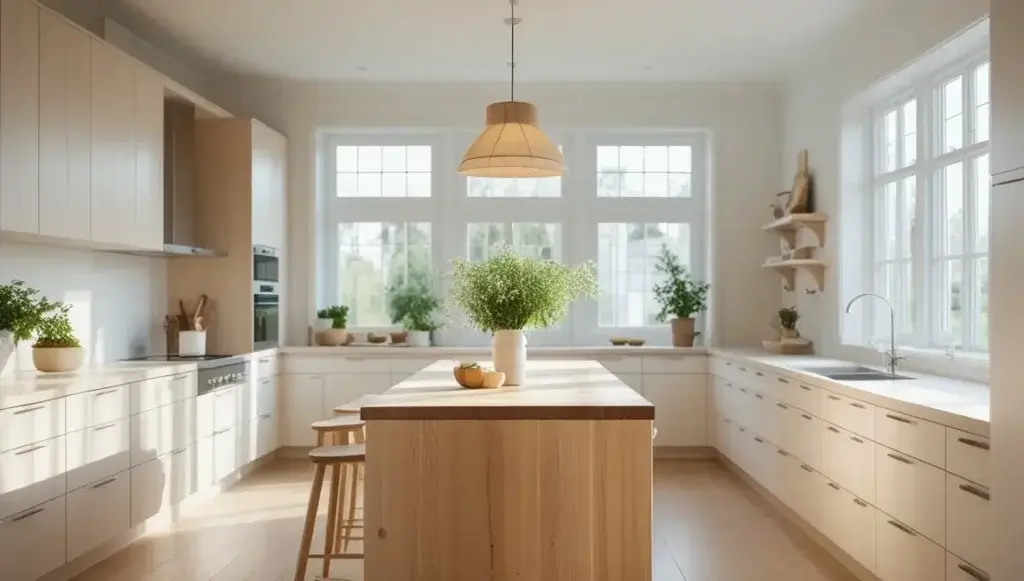
Image Credit: Leonardo AI
Minimalism Meets Functionality
Scandinavian kitchens are a masterclass in minimalism. Born from the Nordic countries, this design style blends simplicity, practicality, and beauty with an effortless ease. These kitchens emphasize clean lines, uncluttered surfaces, and purposeful design.
Function is key. Every drawer, cabinet, and counter space has a role. The layout is usually efficient, with open floor plans and a focus on natural light. Think fewer things, more intention.
Color Palette and Materials
White is the dominant color in Scandinavian kitchens, often paired with light wood finishes like birch or pine. Accents might include pale gray, soft blue, or black for contrast. The color palette keeps everything feeling bright and airy, even in smaller spaces.
For materials, you’ll see a lot of natural elements—wood, stone, and woolen textiles. Cabinetry tends to be handleless or sleek with minimal hardware. Open shelving or glass-front cabinets display everyday items in a neat, attractive way.
Making It Your Own
What sets Scandinavian kitchens apart is their ability to feel calming and cozy—what the Danes call “hygge.” You can bring that feeling into your kitchen with warm lighting, handcrafted ceramics, soft textiles, or even a few potted herbs on the windowsill.
If you’re drawn to clean aesthetics but still want warmth and personality, this style might just be your soulmate.
Pros:
- Bright and Airy: Light colors and natural materials maximize natural light and create a spacious feel.
- Highly Functional: Efficient layouts with purposeful storage reduce clutter and improve usability.
- Timeless Minimalism: Clean lines and simple design resist trends, ensuring longevity.
- Cozy “Hygge” Vibe: Balances minimalism with warmth through textiles, lighting, and decor.
- Eco-Friendly Materials: Emphasis on natural wood and sustainable products aligns with green living.
Cons:
- Maintenance of Light Surfaces: White cabinetry and light woods may show dirt and wear more easily.
- Limited Bold Color: Mostly neutral palette might feel bland to those who prefer vibrant kitchens.
- Less Variety in Textures: Simplicity may come across as too stark or clinical without careful styling.
- Cost of Quality Materials: Natural wood and handcrafted elements can increase expenses.
- Requires Good Lighting: Natural light is crucial; dim spaces may not achieve the same effect.
Estimated Cost Table for Scandinavian Kitchen Design
| Item / Feature | Estimated Cost Range (USD) | Notes |
|---|---|---|
| Light Wood Cabinetry (Birch, Pine) | $8,000 – $16,000 | Handleless or minimal hardware design |
| Quartz or Stone Countertops | $3,000 – $6,000 | Durable, complements natural look |
| Open Shelving / Glass Cabinets | $1,000 – $2,500 | Display everyday items neatly |
| Natural Textile Accessories | $300 – $800 | Wool rugs, linen curtains for warmth |
| Energy-efficient Lighting | $1,000 – $2,500 | Warm lighting enhances “hygge” atmosphere |
| Flooring (Wood or Stone) | $4,000 – $8,000 | Light wood or natural stone |
| Installation & Labor | $3,500 – $7,000 | Skilled carpentry and finish |
Upgrade Your Kitchen Instantly with AI – Click Here
8. Mediterranean Kitchen Design

Image Credit: Leonardo AI
Old World Charm
Mediterranean kitchens feel like a sunny escape to southern Europe. Influenced by the coasts of Italy, Spain, and Greece, these kitchens are full of rich textures, earthy colors, and natural materials that make the space feel like a villa retreat.
They tend to be open and spacious with arched doorways, mosaic tiles, and exposed wooden beams. These elements make the space feel warm, rustic, and just a little bit luxurious.
Key Features and Finishes
Terracotta tiles, wrought iron fixtures, and stone countertops are classic elements in Mediterranean kitchens. Cabinetry is often dark wood—walnut, cherry, or painted in earthy hues like deep blue, olive green, or mustard yellow.
Textured walls (think plaster or stucco), colorful backsplashes with hand-painted tiles, and ornate ironwork create visual interest. Warm, ambient lighting and natural sunlight further enhance the cozy and romantic feel.
Decorating Tips
To capture the Mediterranean spirit, incorporate rustic pottery, wooden bowls, vintage pitchers, or baskets of fresh produce. Plants, especially herbs like rosemary or basil, add a fresh touch and fragrance.
Whether you’re designing a vacation home or just want to bring some European flair into your kitchen, the Mediterranean style is charming, earthy, and timeless.
Pros:
- Warm and Inviting Atmosphere: Rich textures and earthy tones create a cozy, welcoming space.
- Unique Old-World Charm: Distinctive elements like mosaic tiles and wrought iron add character.
- Spacious and Open: Often features open layouts with natural light and architectural details like arches.
- Durable Materials: Stone countertops and terracotta tiles are long-lasting and visually appealing.
- Timeless Appeal: Classic Mediterranean features rarely go out of style, adding lasting value.
Cons:
- High Maintenance Materials: Terracotta and textured walls may require regular upkeep and sealing.
- Potentially Expensive: Custom tile work and ornate fixtures can drive costs up.
- Darker Cabinets: Dark wood finishes may make smaller kitchens feel cramped.
- Style Specific: May not suit modern or minimalist home designs.
- Complex Installation: Mosaic backsplashes and arches require skilled craftsmanship.
Estimated Cost Table for Mediterranean Kitchen Design
| Item / Feature | Estimated Cost Range (USD) | Notes |
|---|---|---|
| Dark Wood Cabinetry (Walnut, Cherry) | $9,000 – $18,000 | Rich finishes, often custom or semi-custom |
| Stone or Granite Countertops | $4,000 – $7,500 | Durable and natural look |
| Mosaic Tile Backsplash | $2,000 – $5,000 | Hand-painted or artisan tiles increase cost |
| Terracotta or Stone Flooring | $5,000 – $10,000 | Requires sealing and maintenance |
| Wrought Iron Fixtures & Lighting | $1,500 – $3,500 | Adds distinctive decorative touches |
| Architectural Details (Arches, Beams) | $3,000 – $8,000 | Skilled labor needed for custom work |
| Installation & Labor | $4,000 – $9,000 | Complex installation demands experienced craftsmen |
Create Your Ideal Kitchen Using AI – Click Here
9. Transitional Kitchen Design

Image Credit: Leonardo AI
The Perfect Blend of Old and New
If you’re stuck between loving traditional kitchens and craving a bit of modern flair, transitional design is the happy middle ground. It combines the warmth and detail of traditional style with the clean lines and simplicity of modern design.
This is one of the most flexible styles out there, and that’s why it’s become incredibly popular. Transitional kitchens often feature shaker-style cabinets, a neutral palette, and a mix of natural and manmade materials.
Why It Works for Many Homes
The beauty of transitional kitchens is their adaptability. They fit just as comfortably in a suburban family home as they do in a sleek city apartment. You get the classic appeal of timeless design with just enough modern updates to keep things fresh.
Transitional design allows you to update your kitchen without going too bold or trendy—perfect for those who want longevity without sacrificing style.
Essential Design Ideas
Keep the color scheme neutral—whites, grays, and soft earth tones. Add warmth with wood or natural stone countertops. Use modern light fixtures to update the space, but keep some traditional details like crown molding or framed cabinets.
Mixing finishes is also encouraged. Pair brushed nickel hardware with marble countertops or combine painted cabinets with a natural wood island. Transitional design is all about balance—and when done right, it feels effortlessly cohesive.
Here’s a detailed analysis of Transitional Kitchen Design including pros, cons, and an estimated cost table:
Pros:
- Versatile and Adaptable: Blends traditional warmth with modern simplicity, fitting many home styles.
- Timeless Appeal: Avoids extremes, providing a look that ages gracefully.
- Balanced Aesthetic: Combines classic details with contemporary updates for harmony.
- Neutral Palette: Easy to customize with accent colors or materials without clashing.
- Increased Resale Value: Broad appeal to a wide range of buyers and tastes.
Cons:
- Can Lack Distinct Personality: Sometimes seen as “safe” or uninspired due to its middle-ground nature.
- Material Mix Challenges: Requires careful selection to avoid clashing finishes or styles.
- Potentially Higher Cost: Combining traditional craftsmanship with modern features can add expense.
- May Feel Overly Neutral: Without bold accents, the design risks feeling bland or generic.
- Requires Skilled Design: Balance is key; poor execution can look mismatched or confusing.
Estimated Cost Table for Transitional Kitchen Design
| Item / Feature | Estimated Cost Range (USD) | Notes |
|---|---|---|
| Shaker-Style Cabinetry | $7,000 – $14,000 | Mix of painted and natural wood finishes |
| Natural Stone or Quartz Countertops | $3,500 – $7,000 | Durable and stylish with varied finishes |
| Modern Light Fixtures | $1,000 – $3,000 | Brushed nickel or matte black options |
| Crown Molding and Trim | $1,000 – $2,500 | Adds traditional detailing |
| Mixed Hardware Finishes | $500 – $1,200 | Brushed nickel, chrome, or matte metals |
| Flooring (Wood or Tile) | $4,000 – $8,000 | Depends on material and pattern choice |
| Installation & Labor | $3,500 – $7,000 | Skilled trades needed for finish quality |
AI Kitchen Design Made Simple – Start Now
10. Coastal Kitchen Design
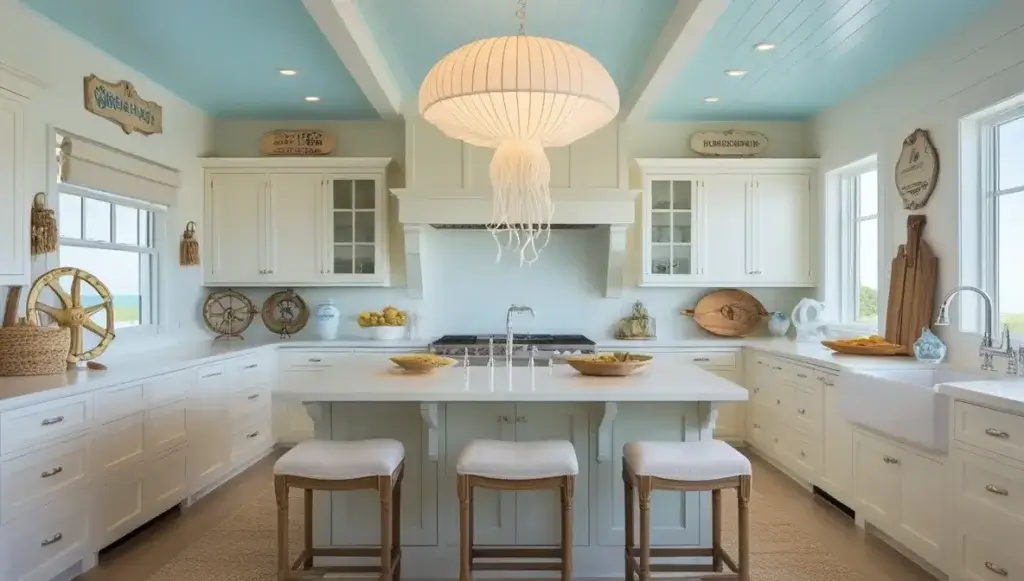
Image Credit: Leonardo AI
Breezy and Relaxed Look
Coastal kitchens channel beachy vibes and relaxed living. Inspired by life along the coast, they’re light, airy, and filled with elements that reflect the sea, sand, and sky. It’s a style that brings a breath of fresh air into your home.
The key is creating a space that feels effortless and calming, with natural light, soft colors, and materials that age gracefully.
Color Schemes and Decor
White and light blue are the go-to colors, often complemented by sandy beige, soft gray, and seafoam green. Open shelving, rattan stools, glass pendant lights, and weathered wood cabinetry add to the laid-back vibe.
Think of natural textures—linen curtains, jute rugs, driftwood accents. Nautical touches like rope decor or seashells should be used sparingly to avoid looking too themed.
How to Keep It Timeless
To keep your coastal kitchen feeling timeless rather than kitschy, focus on elegance over novelty. Use quality finishes like marble or quartz, and choose classic cabinet styles with subtle beach-inspired accents.
Plants, natural woven materials, and clear glass elements help maintain that breezy, open feel. If your kitchen is your happy place, the coastal design will make every day feel like a getaway.
Pros:
- Light, Airy, and Relaxed Atmosphere: Creates a calming, breezy environment reminiscent of beach life.
- Timeless Color Palette: Soft blues, whites, and sandy neutrals maintain freshness and versatility.
- Natural Materials: Use of rattan, linen, and weathered wood adds warmth and texture.
- Open and Inviting Layout: Emphasizes natural light and open shelving for a spacious feel.
- Customizable Nautical Touches: Subtle coastal accents provide personality without overwhelming.
Cons:
- Risk of Over-Themed Look: Too many nautical decorations can make the space feel kitschy or dated.
- Maintenance of Light Surfaces: White and light colors may show dirt and wear more easily.
- Material Sensitivity: Natural elements like rattan and linen can be less durable in busy kitchens.
- May Feel Too Casual: Coastal style might not suit formal or traditional homes.
- Limited Boldness: The subtle palette might feel too muted for those who prefer vibrant kitchens.
Estimated Cost Table for Coastal Kitchen Design
| Item / Feature | Estimated Cost Range (USD) | Notes |
|---|---|---|
| Weathered Wood Cabinetry | $7,000 – $14,000 | Custom finishes for a worn, coastal look |
| Quartz or Marble Countertops | $4,000 – $8,000 | Durable and elegant surfaces |
| Open Shelving and Rattan Accents | $1,000 – $2,500 | Includes shelves, stools, and natural decor |
| Light Fixtures (Glass Pendants) | $1,200 – $3,000 | Soft, airy lighting to enhance natural brightness |
| Flooring (Light Wood or Tile) | $4,000 – $9,000 | Reflects sand tones, durable materials |
| Coastal Decorative Accessories | $300 – $800 | Rope details, ceramics, plants |
| Installation & Labor | $3,500 – $7,000 | Skilled labor for specialized finishes and installation |
Modernize Your Kitchen with AI Tools – Click to Try
11. Minimalist Kitchen Design

Image Credit: Leonardo AI
Less is More
Minimalist kitchen design embraces the mantra that less truly is more. It’s about simplicity, clarity, and intentional living. In a minimalist kitchen, every item has a purpose—and every design choice serves a function. The space feels calm, open, and uncluttered.
This style works best when you want your kitchen to be a stress-free zone, free from visual noise and unnecessary distractions. It’s ideal for small kitchens or anyone who values clarity and order in their cooking space.
Organizing with Purpose
In a minimalist kitchen, storage is your best friend. Clever cabinetry hides away everything from pots to appliances, so countertops stay clean. Drawer dividers, pull-out racks, and hidden garbage bins ensure nothing feels out of place.
Color schemes are typically neutral—white, gray, beige, or black—and everything is streamlined. Cabinet handles are often recessed or completely omitted, and backsplashes are sleek, using materials like glass, quartz, or stainless steel.
Essential Features
Here’s what you’ll typically find in a minimalist kitchen:
- Flat-front cabinets
- Seamless countertops
- Built-in appliances
- A monochromatic or subdued color palette
- Open floor plans with plenty of natural light
To add a bit of personality without breaking the rules, consider incorporating a single standout element—like a sculptural pendant light, a piece of modern art, or a bold kitchen island.
Pros:
- Clutter-Free and Calm: Creates a serene, stress-free environment perfect for focusing on cooking and socializing.
- Highly Functional Storage: Clever, hidden storage solutions keep countertops clean and organized.
- Timeless and Elegant: Neutral palettes and simple forms maintain style longevity.
- Easy to Clean and Maintain: Smooth surfaces and minimal details reduce cleaning time.
- Maximizes Space: Ideal for small kitchens or open floor plans due to its simplicity and openness.
Cons:
- Can Feel Cold or Impersonal: The lack of decoration and warmth might make the space feel sterile or uninviting.
- Limited Color Variety: The neutral and subdued palette might not appeal to those who want vibrant, colorful kitchens.
- High Cost for Quality Materials: Minimalism depends on premium materials and flawless finishes, which can be expensive.
- Requires Discipline: Maintaining the minimalist look requires constant tidiness and avoiding clutter.
- Less Room for Personal Expression: The strict rules of minimalism can limit personalization.
Estimated Cost Table for Minimalist Kitchen Design
| Item / Feature | Estimated Cost Range (USD) | Notes |
|---|---|---|
| Flat-Front Cabinets | $8,000 – $15,000 | Sleek, handleless or recessed handles |
| Seamless Countertops (Quartz, Glass) | $5,000 – $9,000 | High-quality, smooth surfaces |
| Built-in Appliances | $6,000 – $12,000 | Integrated appliances for a streamlined look |
| Lighting (Sculptural Pendants) | $1,000 – $3,000 | Minimalist yet artistic lighting fixtures |
| Flooring (Light or Dark Tiles/Wood) | $4,000 – $8,000 | Clean, uniform flooring that complements the space |
| Storage Accessories | $1,000 – $2,500 | Pull-out racks, drawer organizers, hidden bins |
| Installation & Labor | $4,000 – $7,000 | Skilled labor essential for precision installation |
See Your Future Kitchen with AI – Click Here
12. Bohemian Kitchen Design
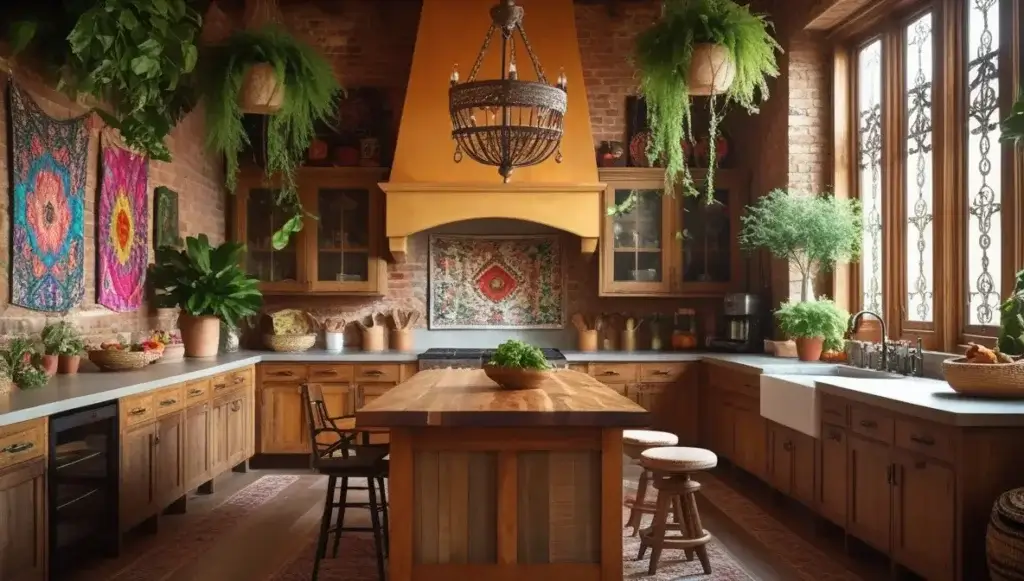
Image Credit: Leonardo AI
Eclectic and Expressive
Bohemian kitchens break all the rules—in the best way possible. This style is about creativity, individuality, and layering. It’s a little vintage, a little global, and a whole lot of color and pattern. No two boho kitchens look alike, and that’s what makes them special.
The design thrives on mixing textures, patterns, and eras. It’s not about perfection; it’s about creating a space that feels collected, lived-in, and full of stories.
How to Mix Patterns and Colors
Don’t be afraid to pair Moroccan tiles with vintage Persian rugs. Combine colorful cabinetry with open shelving showcasing mismatched dishware and handmade ceramics. Introduce rich jewel tones like emerald green, deep burgundy, or mustard yellow.
The trick is in the balance—layer without overwhelming. Try to stick to a loose color palette, even if you’re mixing lots of tones. This helps tie everything together while still keeping the boho spirit alive.
Styling without Chaos
The key to successful bohemian kitchen design is controlled chaos. It should feel artistic and spontaneous, but not messy. Use vintage or handmade furniture, rattan light fixtures, macramé plant hangers, and woven baskets to enhance the eclectic vibe.
Add greenery wherever you can. Hanging plants, potted herbs, and even vertical gardens bring the space to life.
Boho kitchens are perfect for free spirits who want their homes to reflect their personalities and travels. It’s not just a kitchen—it’s a canvas for creativity.
Pros:
- Highly Personalized: Perfect for those who want a kitchen that reflects their unique tastes and travels.
- Vibrant and Warm: Rich colors and layered textures create a lively, inviting atmosphere.
- Creative Freedom: No strict rules—mix and match patterns, eras, and styles with confidence.
- Inviting and Lived-In: Boho kitchens feel warm, cozy, and full of personality.
- Great for Display: Open shelving and eclectic decor let you showcase favorite collectibles and handmade items.
Cons:
- Can Become Overwhelming: Without careful balance, the mix of colors and patterns may feel chaotic.
- Less Cohesive Look: The “collected over time” vibe can sometimes look cluttered if not styled thoughtfully.
- Potentially Costly: Unique vintage or artisan pieces can be expensive or hard to source.
- Challenging for Minimalists: Boho’s maximalist nature is not ideal for those who prefer simplicity.
- Requires Regular Upkeep: To avoid a messy feel, the kitchen needs consistent organization and styling attention.
Estimated Cost Table for Bohemian Kitchen Design
| Item / Feature | Estimated Cost Range (USD) | Notes |
|---|---|---|
| Colorful or Vintage Cabinets | $7,000 – $14,000 | Often painted or distressed finishes |
| Patterned Tiles (Moroccan/Persian) | $3,000 – $7,000 | Floor or backsplash tiles with rich, artistic patterns |
| Open Shelving and Display Units | $1,500 – $3,500 | For showcasing ceramics, plants, and collectibles |
| Unique Lighting (Rattan, Macramé) | $1,000 – $2,500 | Handmade or artisan light fixtures |
| Flooring (Wood or Patterned Tiles) | $4,000 – $8,000 | Mix of vintage and natural materials |
| Decor and Accessories | $1,000 – $3,000 | Woven baskets, rugs, plants, pottery |
| Installation & Labor | $3,500 – $6,500 | Skilled work to integrate eclectic design elements |
AI Can Design Your Dream Kitchen – Explore Today
13. Craftsman Kitchen Design

Image Credit: Leonardo AI
Built to Last
Craftsman-style kitchens are all about quality workmanship and honest materials. Originating from the American Arts and Crafts movement, this style prioritizes durability, handmade details, and a connection to nature.
In a craftsman kitchen, everything feels solid and intentional. It’s not flashy, but it is incredibly beautiful in a subtle, grounded way. Think sturdy cabinetry, visible joinery, and deep, rich wood tones.
Materials and Details
Cabinets are typically made of oak, cherry, or maple, with recessed panels and handcrafted hardware. Tile work—especially handcrafted or subway tile—is common, often used in warm, earthy tones like moss green, russet, or beige.
Built-in features like benches, nooks, and bookshelves add to the “crafted” feel. Crown molding, wainscoting, and wide trim around windows and doors provide architectural interest.
Countertops are often granite or soapstone, with matte or honed finishes that age gracefully. Lighting is subtle and often features Tiffany-style stained glass or mission-inspired fixtures.
Why It’s Making a Comeback
Craftsman kitchens are seeing a resurgence, especially among homeowners who value quality over trendiness. In a world filled with disposable everything, this design style offers something solid, timeless, and enduring.
If you want a kitchen that feels rooted in tradition but still fresh and functional, craftsman style is a wise investment.
Pros of Craftsman Kitchen Design
- High-Quality Materials: Solid wood cabinetry and natural stone surfaces provide exceptional longevity.
- Timeless Aesthetic: Craftsman style doesn’t chase trends, making it appealing across generations.
- Warm and Inviting: Deep wood tones and handcrafted finishes create a cozy, grounded atmosphere.
- Built-In Functionality: Integrated seating, bookshelves, or storage nooks offer added practicality.
- Architectural Detail: Rich millwork, moldings, and visible joinery elevate the overall design.
Cons of Craftsman Kitchen Design
- Higher Initial Cost: Quality materials and craftsmanship come with a premium price tag.
- Heavier Visual Style: The deep woods and detailed features may feel too traditional or heavy for some.
- Less Flexibility for Modern Touches: It’s not ideal if you’re aiming for a sleek or futuristic look.
- Can Feel Dated if Not Done Right: Without fresh accents or updates, it may appear overly retro.
Estimated Cost Table for Craftsman Kitchen Design
| Item / Feature | Estimated Cost Range (USD) | Notes |
|---|---|---|
| Solid Wood Cabinets (Oak, Cherry) | $12,000 – $25,000 | Custom or semi-custom, often with recessed panels and details |
| Natural Stone Countertops | $5,000 – $10,000 | Soapstone, granite, or honed marble with matte finishes |
| Handcrafted Tile Backsplash | $2,000 – $5,000 | Often includes subway or custom ceramic tiles in warm hues |
| Built-in Furniture (benches, nooks) | $3,000 – $7,000 | Adds both function and traditional charm |
| Craftsman Lighting Fixtures | $1,000 – $2,500 | Mission-style or stained glass pendants/sconces |
| Architectural Trim and Moldings | $2,000 – $4,500 | Crown molding, window casings, and wainscoting |
| Labor & Installation | $6,000 – $12,000 | Reflects the detail-oriented nature of this design |
Redesign Your Kitchen with AI, Click here
Conclusion
Choosing a kitchen design style is about more than just looks—it’s about how you live. Whether you’re a minimalist who craves order, a traditionalist who loves timeless elegance, or a boho soul who needs color and creativity, there’s a kitchen style out there that matches your vibe.
This list of the 13 top kitchen design styles shows just how diverse and personalized kitchens can be. You don’t have to stick strictly to one style either—mix and match to create a space that feels perfectly you.
When designing or remodeling your kitchen, start with what makes you feel at home. That’s the style that will never go out of fashion.
FAQs
What is the most timeless kitchen design style?
The traditional kitchen design is often considered the most timeless. With its classic elements like raised-panel cabinetry, neutral colors, and quality materials, it continues to appeal across generations and adds value to any home.
Can I mix two kitchen styles together?
Absolutely. In fact, mixing styles—like transitional or boho—is a great way to personalize your kitchen. Just be sure to find a balance and stick to a cohesive color palette so the final look feels intentional, not chaotic.
What’s the most budget-friendly style?
Minimalist kitchens are generally the most cost-effective since they require fewer decorative details and materials. Flat-pack cabinets, laminate counters, and a neutral color scheme can keep costs down while still looking sleek.
How do I know which kitchen style suits my home best?
Consider your home’s overall architecture and your personal lifestyle. For example, a craftsman kitchen suits a bungalow or older home, while a modern kitchen fits a high-rise condo. Think about your daily habits, the space available, and what styles make you feel comfortable.
Are open shelves still in style in 2025?
Yes, open shelves are still very popular in 2025, especially in Scandinavian, farmhouse, and boho kitchens. They’re a great way to showcase personality through curated dishes and decor, but they do require consistent organization.

My name is Mahi Uddin, and I’m a blog writer with over two years of experience specializing in creating engaging, informative content using AI tools. I contribute to InExDecor.com, where I share creative ideas and practical tips for transforming interior and exterior spaces into beautiful, functional environments. With a passion for storytelling and a knack for blending creativity with technology, I strive to craft blogs that not only inform but also inspire readers. When I’m not writing, you can find me exploring design trends or enjoying a good book with a cup of coffee.

